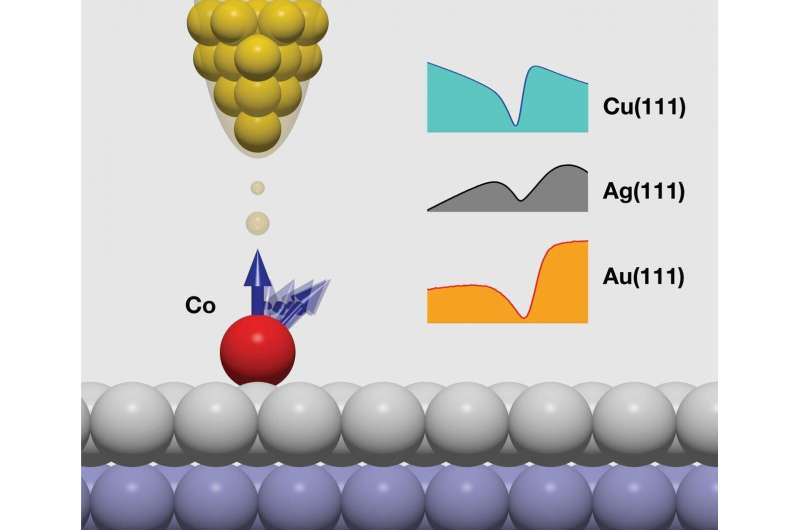Researchers question fundamental study on the Kondo effect

The Kondo effect influences the electrical resistance of metals at low temperatures and generates complex electronic and magnetic orders. Novel concepts for data storage and processing, such as using quantum dots, are based on this. In 1998, researchers from the United States published spectroscopic studies on the Kondo effect using scanning tunneling microscopy, which are considered ground-breaking and have triggered countless others of a similar kind. Many of these studies may have to be re-examined now that Jülich researchers have shown that the Kondo effect cannot be proven beyond doubt by this method. Instead, another phenomenon is creating precisely the spectroscopic 'fingerprint' that was previously attributed to the Kondo effect.
Normally the resistance of metals decreases as the temperature drops. The Kondo effect causes it to rise again below a threshold value typical to the material in question, the so-called Kondo temperature. This phenomenon occurs when magnetic foreign atoms, such as iron, contaminate non-magnetic host metals, such as copper. Simply put, when a current flows, the atomic nuclei are engulfed by electrons. The iron atoms have a quantum mechanical magnetic moment. This causes the electrons in the vicinity to align their spin antiparallel to the moment of the atom at low temperatures and to hang around the cobalt atom like a cloud on a mountaintop. This hinders the flow of the electrons—the electrical resistance then increases. In physics, this is known as entanglement, the strong coupling of the moment of the impurity with the spins of the surrounding electrons. This effect can be exploited, for example in the form of quantum dots: nanocrystals that could one day serve as miniscule information storage or processor elements.
The Kondo effect had already been observed in 1934 and was fundamentally explained by Jun Kondo in 1964. In 1998, experimental physicists achieved a methodological breakthrough in the study of the effect. By means of scanning tunneling microscopy, it had become possible to detect and position individual atoms on surfaces and to record energy spectra specifically at these points. A characteristic dip in the measurement curve was found at the position of cobalt atoms on a gold surface, which from then on was considered the marker for the Kondo effect. Previously, the Kondo effect could only be detected indirectly via resistance measurements. Further investigations of other material combinations and atomic arrangements using this technique followed on as a result, and a separate field of research was created, dedicated to the investigation of many-body phenomena with atomic resolution.
However, the physicists from the Peter Grünberg Institute and the Institute for Advanced Simulation at Forschungszentrum Jülich have now found an alternative cause for the dip in the energy spectrum: so-called magnetic anisotropy. Below a specific temperature, this causes the magnetic moment of the foreign atom to couple to the crystal lattice of the host metal, so that the orientation of the moment virtually "freezes". Above this temperature, excitations of the magnetic moment occur due to the spin properties of the tunneling electrons of the microscope. Scientists were not yet able to measure this type of spin excitation in 1998.
The researchers have been working for years to improve theoretical models for spin excitation. Early on they found evidence of the Kondo-like marker. Initially, however, they still lacked the ability to consistently include important, so-called relativistic effects in their calculations. Once they had succeeded in doing so, they took another look at the system of cobalt and gold. They were now able to back up their calculations impressively with data from scanning tunneling spectroscopy studies. Both the measured and calculated spectra are approximately in agreement.
"This means that much of what we thought we had learned about the Kondo effect over the last two decades, and which has already found its way into textbooks, needs to be re-examined," explains Prof. Samir Lounis, head of the Functional Nanoscale Structure Probe and Simulation Laboratory (Funsilab). The scientists are already proposing the first new experiments based on their predictions.
More information: Juba Bouaziz et al, A new view on the origin of zero-bias anomalies of Co atoms atop noble metal surfaces, Nature Communications (2020). DOI: 10.1038/s41467-020-19746-1
Journal information: Nature Communications
Provided by Forschungszentrum Juelich





















